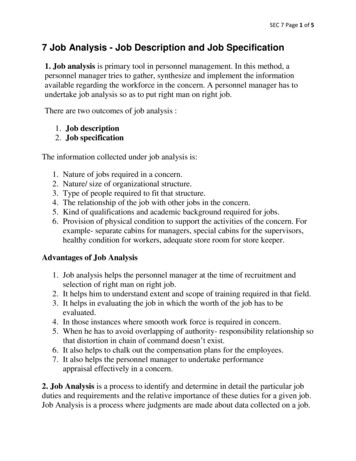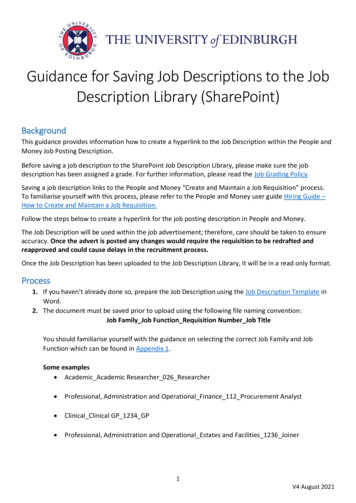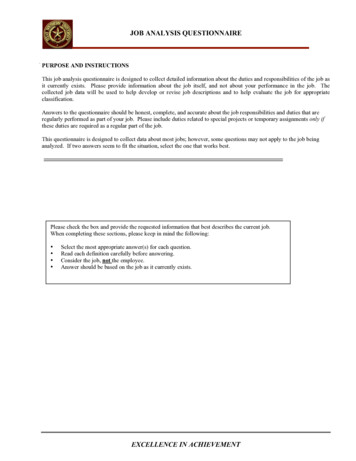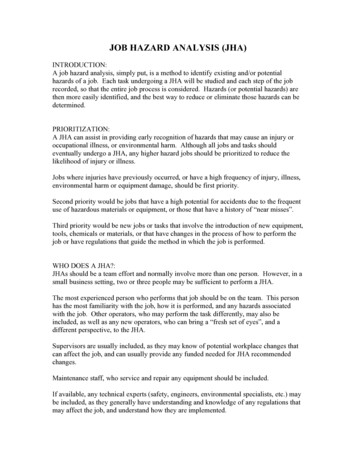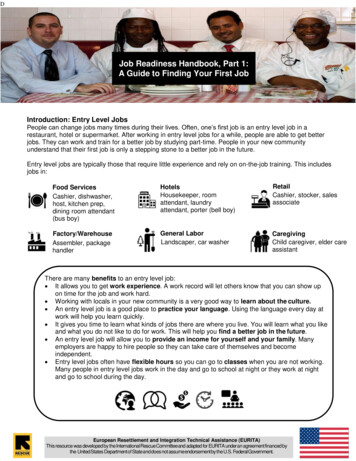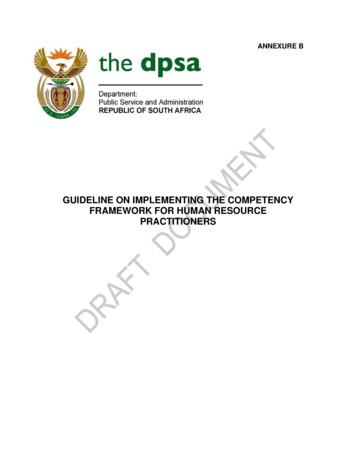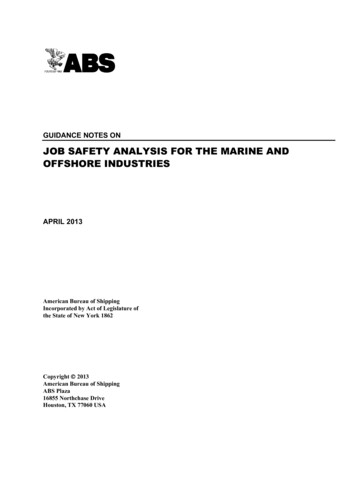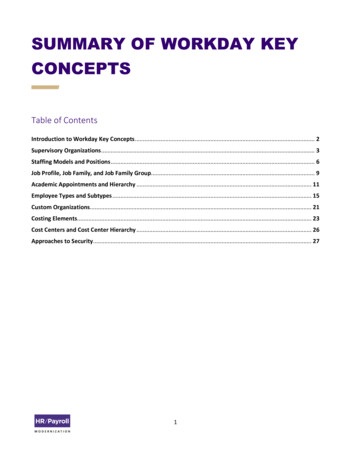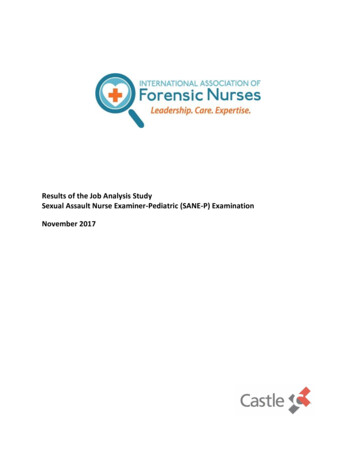
Transcription
Results of the Job Analysis StudySexual Assault Nurse Examiner-Pediatric (SANE-P) ExaminationNovember 2017
Results of the Job Analysis Study for theInternational Association of Forensic Nurses (IAFN)Sexual Assault Nurse Examiner-Pediatric (SANE-P) ExaminationInternational Association of Forensic Nurses6755 Business Parkway, Suite 303Elkridge, MD 21075Document prepared by:Castle Worldwide, Inc.6001 Hospitality Court, Suite 100Morrisville, NC 27560 USA919.572.6880www.castleworldwide.comCopyright 2017 by the International Association of Forensic Nurses. All rights reserved. Thispublication is protected by copyright. No part of it may be reproduced, stored in a retrieval system, ortransmitted in any form or by any means, electronic, mechanical, photocopying, recording, or otherwisewithout written permission from the International Association of Forensic Nurses.Any authorized reproduction of this document shall display the notice: “Copyright by InternationalAssociation of Forensic Nurses. All rights reserved.” Or, if a portion of the document is reproduced orincorporated in other materials, such written materials shall include the following credit: “Portionscopyrighted by International Association of Forensic Nurses. All rights reserved.”Address inquiries in writing to International Association of Forensic Nurses, 6755 Business Parkway,Suite 303, Elkridge, MD 21075.
Table of ContentsExecutive Summary . 1Job Analysis Study Methodology . 1Summary of the Content Outline Development Process . 2Introduction . 3Phase I: Initial Development . 5Changes to the Practice of Sexual Assault Nursing . 5Defining the Target Audience . 5Reviewing and Developing Tasks . 5Reviewing and Developing Domains . 6Phase II: SANE-P Validation Survey . 7Questionnaire Design and Distribution . 7Response Rates . 7Responses to Demographic Questions . 7Evaluation of Domains and Tasks . 12Responses to the Task Statements . 13Responses to the Domains . 15Phase III: Test Blueprint for the SANE-P Examination . 16Test Blueprint . 17References . 20AppendicesSANE-P Job Analysis Panel Workbook . Appendix AAttendees of the SME Panel Meeting . Appendix BPanel Member Demographics. Appendix CWorkshop Feedback . Appendix DEmail Requests Sent to Potential Survey Respondents . Appendix E
EXECUTIVE SUMMARYThe International Association of Forensic Nurses (IAFN) is a not-for-profit certifying body for individualswho practice in the field of nursing where the healthcare system and the legal system intersect. The aimof IAFN’s Sexual Assault Nurse Examiner-Pediatric (SANE-P) certification program is to assess anindividual’s knowledge of the practice of forensic nursing that specializes in sexual assault care of thepediatric population.In 2017, IAFN conducted an analysis of the practice of forensic nursing to help ensure that the contenttested on the SANE-P certification exam reflects current practice. IAFN worked with Castle Worldwide,Inc., a certification and licensure design, development, and administrative service company, to ensurethat certificate examinations meet guidelines and standards for examination development (e.g.,Standards for Educational and Psychological Testing, American Educational Research Association, 2014;Uniform Guidelines on Employee Selection Procedures, EEOC, 1978). A summary of the 2017 job analysisis provided below.Job Analysis Study MethodologyThe job analysis for the certification examination consisted of three phases:I. Initial Development A seven-member panel of subject matter experts reviewed the performance domains and tasksessential for competent and safe practice in Morrisville, NC on May 1-2, 2017. After discussingthe changes in practice since the previous job analysis and reviewing the eligibility requirementsfor the certification, the panel identified 46 core tasks that were deemed to be an essential partof entry level practice as a SANE-P. These tasks were organized into five broad domains ofpractice.II. Validation Survey A sample of professionals reviewed and validated the work of the panel through an onlinesurveyRespondents were SANE-P certificantsA total of 419 requests for participation were sent103 respondents completed at least 70% of the survey, a response rate of 25%.At the time of taking the survey, all of respondents were U.S.-basedIII. Development of Test Specifications Based on the ratings gathered from the full validation study, the test blueprint specifications forthe certification examination were developed.A relative importance weight was calculated for each task by multiplying each respondent’srating of criticality by their rating of frequency (relative importance criticality*frequency).A combination of combination of “top-down”, “bottom-up”, and “SME panel” approaches wereused to establish the domain weights for the exam blueprint. Once the domain weights wereestablished, the top-down was used to distribute the task weights accordingly. The top-downInternational Association of Forensic NursesJob Analysis Study for SANE-P Examinationpage 1
approach assigns task weights based on the domains deemed the most important by the surveyrespondents.The IAFN board reviewed and accepted panel recommendations in October 2017Summary of the Content Outline Development ProcessBased on the results of the three phases, the SANE-P practice analysis study provided a test specificationbreakdown, also known as the test blueprint. The test blueprint, found in Table 1, below, identifies thepercentages assigned to each domain tested by the examination.Table 1. Test Blueprint and Specification, IAFN SANE-P Validation Survey 2017ID DescriptionPercent of ExamAssessment and Documentation34%1Evidence Collection14%2PatientManagement30%3Legal Issues and the Judicial Process10%4Professional Practice12%5International Association of Forensic NursesJob Analysis Study for SANE-P Examinationpage 2
INTRODUCTIONEstablished in 1992 as an independent not-for-profit organization, the International Association ofForensic Nurses (IAFN) was created as an organization that encompasses the depth and breadth of thosewho practice nursing where the healthcare system and the legal system intersect. IAFN certified nursespractice in roles as death investigators, correctional nurse specialists, forensic psychiatric nurses, legalnurse consultants, forensic geriatric specialists, nurse attorneys, forensic clinical nurse specialists,forensic gynecology nurses, and those who work in other settings as forensic practice evolves. IAFNserves the public interest by developing, administering, and continually reviewing a certification processthat reflects current standards of competent practice in forensic nursing. The aim of IAFN’s SexualAssault Nurse Examiner-Pediatric (SANE-P) certification program is to assess an individual’s knowledgeof the practice of forensic nursing that specializes in sexual assault care of the pediatric population.In 2017, IAFN began the process of reviewing and updating the test blueprint for the SANE-Pexamination. IAFN worked with Castle Worldwide, Inc., a certification and licensure design,development, and administrative service company, to ensure that the certification examination meetsguidelines and standards for examination development (e.g., Standards for Educational andPsychological Testing, American Educational Research Association, 2014; Uniform Guidelines onEmployee Selection Procedures, EEOC, 1978). This report details the 2017 job analysis, which is anupdate to the 2011 job analysis and was held in Morrisville, NC on May 1-2, 2017.A practice, or job, analysis study aims to ensure that an examination is content valid. Content validity isthe most commonly applied and accepted validation strategy used in establishing certification programs.Validation is the way a developer documents that the competence to be inferred from a test score isactually measured by the examination.A valid examination appropriately evaluates the knowledge and/or skills required for an individual tofunction as a competent practitioner in the field. A job analysis study is an integral part of ensuring thatthe aspects of the profession or professional role covered on the examination reflect the tasksperformed in practice settings. For both broad content areas and tasks, a job analysis identifies criticalityand frequency. These ratings play an important part in determining the content of the examination.To qualify for admission to the SANE-P examination, an applicant must comply with all regulations thatare in effect at the time the application is filed. To be eligible to sit for the SANE-P certificationexamination, each candidate must:1. Hold an active, unrestricted license as a registered nurse (RN) in the United States or a US territoryORHold an active, unrestricted license as a first-level general nurse (or the equivalent) in thecountry/jurisdiction of practice;AND2. Have practiced nursing for a minimum of three (3) years as an RNORHave practiced nursing for a minimum of three (3) years as a first-level general nurse (or theequivalent) in the country/jurisdiction of licensure;ANDInternational Association of Forensic NursesJob Analysis Study for SANE-P Examinationpage 3
3. Have successfully completed a pediatric sexual assault nurse examiner education program thatgrants a minimum of forty (40) hours of continuing nursing education contact hours from anaccredited providerORHave successfully completed a pediatric sexual assault nurse examiner education program thatcomprises a minimum of forty (40) hours of academic coursework or the national equivalent froman accredited educational institutionORHave successfully completed a combined adult/adolescent and pediatric sexual assault nurseexaminer education program that grants a minimum of sixty-four (64) hours of continuing nursingeducation contact hours from an accreditedORHave successfully completed a combined adult/adolescent and pediatric sexual assault nurseexaminer education program that comprises a minimum of sixty-four (64) hours of academiccoursework or the national equivalent from an accredited educational institution;AND4. Have successfully completed a sexual assault nurse examiner clinical preceptorship as outlined inthe most current edition of the IAFN Sexual Assault Nurse Examiner Education Guidelines;AND5. Have practiced as a sexual assault nurse examiner and/or have provided clinical instruction forsexual assault nurse examiners for a minimum of 300 hours within the past three (3) years. At least200 of those 300 hours must comprise SANE-related practice that is focused on the prepubertalpatient population.The 2017 job analysis study for the IAFN SANE-P consisted of three phases:I. Initial Development. This phase consisted of a panel of subject matter experts who identified thedomains and tasks essential to the competent performance of a sexual assault nurse that specializesin the care of the pediatric population.II. Validation Study. Certificants of SANE-P reviewed and validated the work of the panel.III. Development of Test Specifications. Based on the ratings gathered from the SANE-P certificants thetest specifications for the certification examination were developed.Each of these three phases will be described in detail in subsequent sections.International Association of Forensic NursesJob Analysis Study for SANE-P Examinationpage 4
PHASE I: INITIAL DEVELOPMENTThe first steps in reviewing the role of the SANE-P were the review and modification of the existing testblueprint domains and tasks. To achieve these goals, IAFN contracted with Castle Worldwide to lead apractice analysis study panel.In 2017, IAFN assembled a seven-member panel of subject matter experts in the sexual assault nursingfield to discuss the role of the SANE-P. Panel members were selected by IAFN to represent a broad rangeof sexual assault nursing experiences and were also selected in order to reflect a mix of members whosupervised, educated, or were recently certified. All panelists were current SANE-A and SANE-Pcertificants. Appendix A contains the content of the workbook, including the agenda, used for themeeting. A complete listing of the panel members is contained in Appendix B. Appendix C contains asummary of the panel’s demographic characteristics.Changes to the Practice of Sexual Assault NursingThe meeting began with a discussion of changes to the field of sexual assault nursing that may haveoccurred since the 2011 practice analysis. The goal of this conversation was to ensure that any changesto the field were captured by the panel in subsequent discussions about the role of the SANE-P andupdates to the blueprint. Recent trends were discussed and were kept in mind throughout the meetingas job tasks of a forensic nurse and the knowledge and skills needed to perform those tasks werediscussed.Defining the Target AudienceThe panel initially reviewed the criteria required for taking the SANE-P examination and clarified theirunderstanding of the target audience for the examination. The panel members were reminded that thetarget audience is composed of individuals that hold an active, unrestricted license as a registered nurse(RN) or first-level general nurse, practiced as a registered nurse (RN) or first-level general nurse for aminimum of three years, have successfully completed a pediatric sexual assault nurse examinereducation program, have successfully completed a sexual assault nurse examiner clinical preceptorship,and have practiced as a sexual assault nurse examiner and/or have provided clinical instruction forsexual assault nurse examiners for a minimum of 300 hours within the past three years.Reviewing and Developing TasksThe panel members were then introduced to the idea of what constitutes a task (see Appendix A). Panelmembers were instructed that it is necessary to include tasks that are important for the safe andcompetent practice of recently certified SANE-Ps in an examination program. Panel members were alsoadvised that the tasks for the SANE-P test blueprint should be: Critical – Failure to perform the task competently would result in negative consequences forpatients, clients, or other stakeholders.Frequently performed – The task is performed regularly in entry-level practice. Exceptions canbe made for tasks that are performed infrequently but are critical.Central – The task is a key part of the job or role and not a supporting task (e.g., marketing,administrative functions).International Association of Forensic NursesJob Analysis Study for SANE-P Examinationpage 5
The panel initially reviewed the existing 44 tasks and modified them for clarity, accuracy, andconciseness. From this process a set of 46 tasks were identified as appropriate to the role of a newlycertified SANE-P.Reviewing and Developing DomainsThese 46 tasks were then grouped into five broad performance domains. A domain was defined as amajor area of responsibility or duty that makes up the role of a SANE-P. The five performance domainsdefined by the panel were:1.2.3.4.5.Assessment and Documentation (14 Tasks)Evidence Collection (5 Tasks)Patient Management (15 Tasks)Legal Issues and the Judicial Process (4 Tasks)Professional Practice (8 Tasks)International Association of Forensic NursesJob Analysis Study for SANE-P Examinationpage 6
PHASE II: SANE-P VALIDATION SURVEYQuestionnaire Design and DistributionIAFN contracted with Castle Worldwide, Inc. to conduct a validation survey of the domains and tasks.The survey was conducted beginning August 9, 2017and closed on August 31, 2017. Using the domainsand tasks identified by a practice analysis panel in conjunction with IAFN staff, Castle Worldwide, Inc.developed an online questionnaire to be completed by SANE-P certificants.The survey consisted of two parts. The first part asked respondents to rate the tasks and domains in thatorder. The second part, or demographics section, consisted of a series of questions that askedrespondents to provide information about their place of work and working conditions, for example, thetype of facility in which they work.IAFN staff provided Castle with the names and e-mail addresses of the 419 recently certified SANE-Ps.These 419 potential respondents were sent an initial e-mail requesting that they complete the surveyand evaluate, validate, and provide feedback on the previously identified domains and tasks. Twofollow-up e-mails were sent to those who had not responded or who had started but not completed thesurvey: one reminder was sent after two weeks and one was sent when only one day was remaining.(See Appendix D for e-mail invitations.)Response RatesA total of 103 respondents completed at least 70% of the survey. This represents an overall responserate of 25%. The majority of Castle’s clients experience a 25% to 50% response rate on similar surveys,and within the wider community, a 5% to 15% response rate is typical (De Champlain, Cuddy, & LaDuca,2007). Of this group, 103 (100%) were U.S.-based.Responses to Demographic QuestionsThe SANE-P survey consisted of a number of demographic questions. The responses to these questionsare noted below.GenderRespondents were provided three options (Male, Female, and Other). Table 2 provides a breakdown fornumber of respondents who identified themselves in each category.Table 2. Responses by Gender, IAFN SANE-P Validation Survey ther100Answered question3Skipped questionInternational Association of Forensic NursesJob Analysis Study for SANE-P Examinationpage 7
Birth YearRespondents were provided six options to report the year of their birth (1912-1932, 1933-1945, 19461964, 1965-1976, 1977-1989, and 1990-present). Table 3 provides a breakdown for number ofrespondents who identified themselves in each category.Table 3. Responses by Age Group, IAFN SANE-P Validation Survey 2017Birth sent4.0%4Answered question100Skipped question3LocationRespondents asked to report the state/province/territory in which they live. Table 4 provides abreakdown for number of respondents who identified their state of residence.Table 4. Responses by Location, IAFN SANE-P Validation Survey .3%5American Colorado5.3%5Connecticut1.1%1Delaware0.0%0District of nternational Association of Forensic NursesJob Analysis Study for SANE-P Examinationpage 8
issouriMontanaNebraskaNevadaNew HampshireNew JerseyNew MexicoNew YorkNorth CarolinaNorth DakotaNorthern Mariana IslandsOhioOklahomaOregonPennsylvaniaPuerto RicoRhode IslandSouth CarolinaSouth DakotaTennesseeTexasUnited States Minor Outlying IslandsUtahVermontVirgin IslandsVirginiaWashingtonWest VirginiaWisconsinWyomingAnswered questionSkipped 07101001140830052130010113010071030958Education at EntryRespondents were provided four options (Diploma in Nursing, Associate Degree in Nursing, Bachelor's inNursing, and Other). Table 5 provides a breakdown for number of respondents who identifiedthemselves in each category.International Association of Forensic NursesJob Analysis Study for SANE-P Examinationpage 9
Table 5. Responses by Education at Entry, IAFN SANE-P Validation Survey 2017PercentCountEntry-Level EducationDiploma in Nursing19.2%19Associate Degree in Nursing36.4%36Bachelor's in Nursing39.4%39Other5.1%5Answered question99Skipped question4Highest Level of EducationRespondents were provided six options to describe their highest degree (Diploma in Nursing, AssociateDegree in Nursing, Bachelor's in Nursing, Master’s on Nursing, Doctorate in Nursing, and Other). Table 6provides a breakdown of the number of respondents who identified themselves in each category.Table 6. Responses by Highest Level of Education, IAFN SANE-P Validation Survey 2017Highest DegreePercentCountDiploma in Nursing10.1%10Associate Degree in Nursing17.2%17Bachelor's in Nursing33.3%33Master's in Nursing28.3%28Doctorate in Nursing (e.g., PhD, DNSc, DNP)6.1%6Other5.1%5Answered question99Skipped question4ExperienceRespondents were provided eight options (Less than 1 year, 1 year, 2 years, 3 years, 4 years, 5 years, 610 years, 11 or more years). Table 7 provides a breakdown of the number of respondents who identifiedthemselves in each category.Table 7. Responses by Experience, IAFN SANE-P Validation Survey 2017Years of ExperiencePercentCountLess than 1 year0.0%01 year0.0%02 years1.0%13 years4.0%44 years6.0%65 years7.0%76-10 years20.0%2011 or more years62.0%62Answered question100Skipped question3International Association of Forensic NursesJob Analysis Study for SANE-P Examinationpage 10
Employment StatusRespondents were asked to select their employment status from a list of seven options (Working fulltime, Working part-time, Full-time student, Part-time student, Unemployed, Retired, Other) and wereable to select more than one option, if applicable. Several respondents selected two categories,resulting in the total number of responses exceeding the number of individuals who answered thequestion. Table 8 provides a breakdown of the number of responses received in each category.Table 8. Responses by Employment Status, IAFN SANE-P Validation Survey 2017DescriptionPercentCountWorking full-time (35 hours or more per week)7266.1%Working part-time (less than 35 hours per week)2724.8%Full-time student21.8%Part-time student32.8%Unemployed10.9%Retired10.9%Other (please specify)32.8%Total responses109Answered question100Skipped question3Practice settingRespondents were asked to select the best description of their practice setting from a list of sevenoptions. Table 9 provides a breakdown of the number of respondents who identified themselves in eachcategory.Table 9. Responses by Practice Setting, IAFN SANE-P Validation Survey 2017Primary Practice SettingPercentHospital-Based60.6%Community-Based, medical22.2%Community-Based, non-medical2.0%Governmental organizations and programs, medical or non-medical3.0%Educational or industrial settings3.0%Legal or investigative arenas1.0%Long-term care, skilled nursing, and rehabilitation settings0.0%Residential and correctional institutions0.0%Not currently employed1.0%Other7.1%Answered questionSkipped questionCount602223310017994EthnicityRespondents were provided eight options to report the year of their ethnicity (American Indian orAlaska Native Asian, Black or African American, Hispanic/Latino of any race, Multi-racial, NativeInternational Association of Forensic NursesJob Analysis Study for SANE-P Examinationpage 11
Hawaiian or Other Pacific Islander, White, Prefer not to answer). Table 10 provides a breakdown of thenumber of respondents who identified themselves in each category.Table 10. Responses by Ethnicity, IAFN SANE-P Validation Survey 2017EthnicityPercentCountAmerican Indian or Alaska Native2.0%2Asian0.0%0Black or African American1.0%1Hispanic/Latino of any race3.0%3Multi-racial3.0%3White87.0%87Prefer not to answer4.0%4Answered question100Skipped question3Evaluation of Domains and TasksThe SANE-P Job Analysis survey respondents were asked to evaluate each performance domain andtask, rating each on criticality, frequency, and need at entry. Respondents were asked to rate criticality,frequency, and need at entry based on following scales:Criticality: To what extent would harm (physical, emotional, financial, etc.) result if a SANE-P could notperform this task successfully?1 No harm2 Minimal harm3 Moderate harm4 Substantial harm5 Extreme harmFrequency: How frequently would a newly certified SANE-P be expected to perform this task?1 Never2 Occasionally3 Frequently4 AlwaysNeed at Entry: Is the SANE-P expected to be able to perform this task immediately at the point ofcertification?1 Yes, they should be able to perform this task within the first few months after being certified.2 No, this is a task that is generally performed several months or more after the point of certification.For criticality, frequency, and need at entry respondent ratings were scored, which enabled thedevelopment of an appropriate metric for weighting the domains and tasks. For each respondent, afourth variable, relative importance, was calculated by multiplying each respondent’s criticality by theirInternational Association of Forensic NursesJob Analysis Study for SANE-P Examinationpage 12
rating of frequency (relative importance criticality*frequency). The relative importance provides anassessment of the relative weight of the domains and tasks used to establish the test blueprint. Thus,tasks rated low in both criticality and frequency will be given a low relative importance weight and tasksrated high in both criticality and frequency will be given a high relative importance weight.Responses to the Task StatementsTable 11 provides the mean and standard deviation of frequency, criticality, and relative importance foreach of the 46 tasks identified by the Practice Analysis panel.International Association of Forensic NursesJob Analysis Study for SANE-P Examinationpage 13
Table 11. Task Ratings, IAFN SANE-P Validation Survey 2017CriticalityFrequencyDomain rnational Association of Forensic NursesJob Analysis Study for SANE-P ative Importance (C x .785.00page 14
Responses to the DomainsAfter rating the tasks respondents were asked to rate the percentage of the exam that should bedevoted to each dom
Standards for Educational and Psychological Testing, American Educational Research Association, 2014; Uniform Guidelines on Employee Selection Procedures, EEOC, 1978). A summary of the 2017 job analysis . nurse consultants, forensic geriatric specialists, nurse attorneys, forensic clinical nurse specialists, forensic gynecology nurses, and .


